Scrum of Scrums sounds like the ultimate glorious accolade awarded to the best Scrum project team of the year. Or, possibly, the best-executed rugby scrum of the season.
In reality, it’s the functional term used by organizations running multiple interconnected Scrum projects that fall under one much larger overarching project.
In this guide, we’ll define Scrum of Scrums and highlight its purpose, benefits, and best practices. Plus, we’ll show you how you can streamline your Scrum of Scrum meetings with monday dev and set your product development teams up for success.
Try monday devWhat is Scrum of Scrums?
Scrum of Scrums (sometimes referred to as SoS) is a scaled Agile technique used to coordinate multiple Scrum teams working on the same large project or product development. It allows agile teams to communicate and coordinate efforts, avoid conflicts, and integrate their work effectively.
How it works
Typically, a Scrum team consists of 10 or fewer people with three defined roles: a product owner, a Scrum master, and several team members. With large projects, it’s unlikely that a small Scrum team can handle everything, so multiple small teams are used.
- Representatives from each Scrum team (often the Scrum Master or a designated team member) attend the Scrum of Scrums meeting.
- Meetings are typically held daily, twice a week, or at least once a week.
- Meetings are similar to daily Scrum meetings but not limited to 15 minutes.
Scrum of Scrums history
Scrum of Scrums was first introduced by Jeff Sutherland and Ken Schwaber in 1996 to coordinate the activities of eight business units with multiple product lines. They experimented by gathering all eight product teams into a single room to form a meta-team or “Scrum of Scrums” and create an environment where independent teams could synchronize their efforts more efficiently.
The concept gained wider recognition after Sutherland published an article in 2001 titled “Agile Can Scale: Inventing and Reinventing SCRUM in Five Companies.” The article described his experiences working with hundreds of developers on dozens of products at IDX Systems (now GE Healthcare) and mentioned Scrum of Scrums for the first time in a published format.
Scrum of Scrums diagram
In the graphic below, representatives from several Scrum teams filter up to attend the Scrum of Scrums meeting:
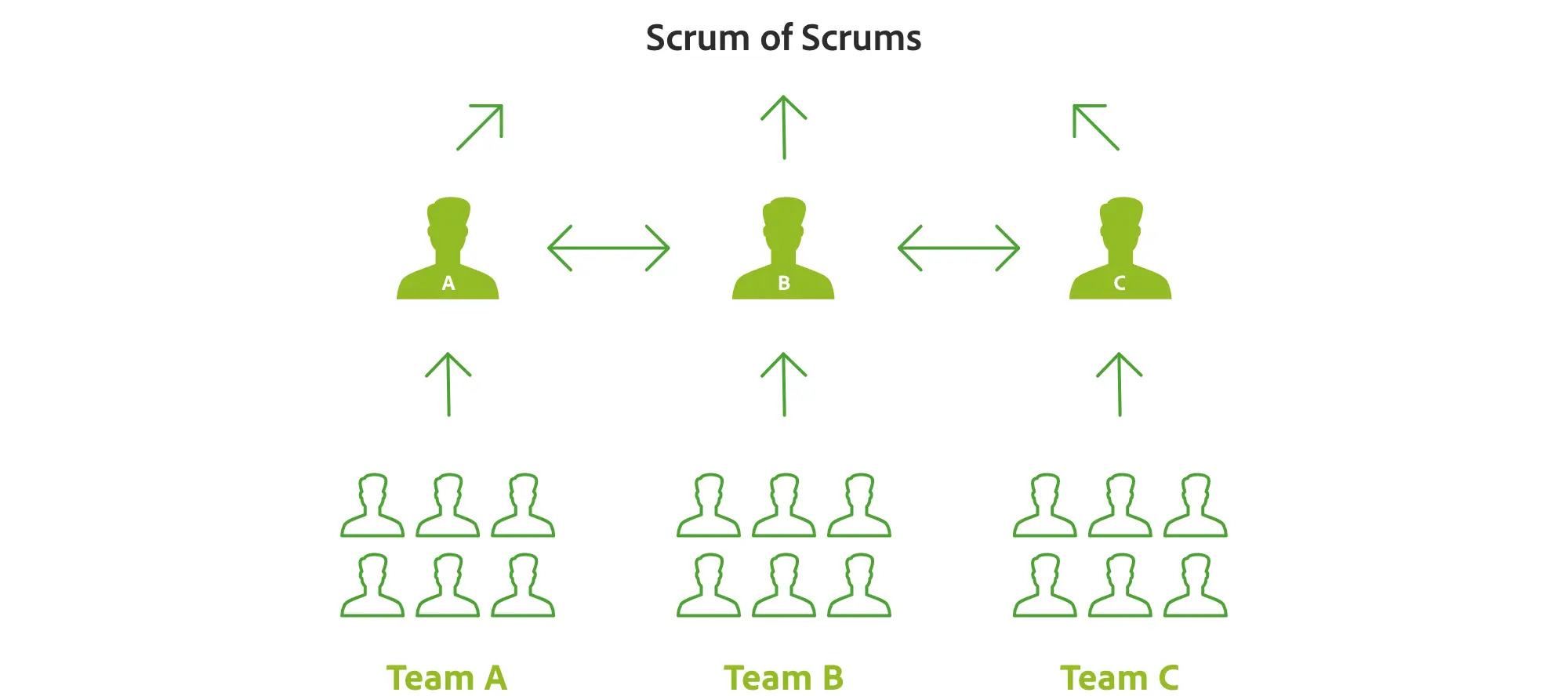
It shows how multiple small Scrum teams can remain agile while still coordinating their efforts at a higher level through their representatives in the Scrum of Scrums meeting.
What is the purpose of Scrum of Scrums?
The primary purpose of Scrum of Scrums is to:
- Coordinate and integrate the work of multiple Scrum teams working on the same large project or complex solution.
- Facilitate communication and planning across Scrum teams, addressing dependencies and highlighting points of integration or conflict.
- Eliminate impediments to optimizing team coordination, which may involve teams working together temporarily or renegotiating areas of responsibility.
- Ensure delivery of a fully integrated product by organizing smaller, independent teams to coordinate their efforts.
- Scale Agile practices for larger projects or organizations to manage the delivery of more complex projects.
- Allow each subteam to plan its work independently while still coordinating with the rest of the group.
- Provide a platform for teams to see the “bigger picture” of the project and understand how their work affects other teams.
- Minimize the risk of teams’ work adversely impacting each other.
- Support teams in addressing problems and making minor course corrections as needed.
- Optimize workflow within the whole project by facilitating cross-team synchronization.
In essence, the Scrum of Scrums serves as a crucial coordination and communication mechanism for large-scale Agile projects involving multiple teams, ensuring that all teams are aligned, integrated, and working efficiently towards common goals.
The benefits of Scrum of Scrums
Organizations can effectively scale Agile practices, enhance cross-team coordination, and improve overall project delivery with Scrum of Scrums. Here are the main advantages:
Facilitates scaling of Scrum for larger projects and organizations
Scrum of Scrums allows multiple small Scrum teams to maintain their ideal size (4-9 members) while collaborating on larger projects. This enables large enterprises to use the Scrum methodology effectively and avoid pitfalls such as redundancy and inefficiency.
Enhances coordination and collaboration
Scrum of Scrums improves coordination and streamlines collaboration across multiple teams on complex projects. This ensures comprehensive synchronization as teams work together on larger projects, enabling them to deliver value more quickly.
Improves problem-solving
Scrum of Scrums allows teams to gain new perspectives and creative ideas from other teams. It also offers a forum for airing out issues and difficulties, making problem-solving easier.
Fosters communication and information sharing
Scrum of Scrums guarantees every team stays informed through its representation. It also promotes open communication and collective decision-making.
Aligns team objectives
Scrum of Scrums helps align individual team objectives with broader project goals. It reinforces each team’s role and keeps them on track.
Increases transparency and adaptability
Scrum of Scrums ensures multiple groups or departments can handle new, unforeseen developments. It also encourages consensus and reduces conflict across all project teams.
How often should the Scrum of Scrums meeting be held?
Unlike the regular Scrum meetings, there is no set frequency for the Scrum of Scrums meeting. Ultimately, it’s up to the teams involved to determine the frequency based on the project’s complexity, the level of inter-team dependencies, and the need for coordination. Here are four options to consider:
- Daily meetings. Ken Schwaber, one of the co-creators of Scrum, initially suggested that Scrum of Scrums meetings should be held daily, similar to the daily stand-up, and timeboxed to 15 minutes.
- Two to three times a week. Many organizations prefer to hold Scrum of Scrums meetings less frequently, typically two or three times a week. This approach is often seen as more practical and allows for longer meeting times when needed.
- At least once a week. Some practitioners suggest that Scrum of Scrums meetings should be held at least once a week, with the exact frequency determined by the project requirements.
- Flexible scheduling. Alternatively, companies can adjust the frequency based on the current phase of development and the complexity of the project.
When opting for less frequent meetings, schedule longer time slots (30-60 minutes) to allow for more in-depth problem-solving and discussion. This approach recognizes that issues raised in Scrum of Scrums often require more time to address than those in daily stand-ups.
Who participates in Scrum of Scrums meetings?
The participants in a Scrum of Scrums meeting typically include:
- Chief product owner: Provides valuable input, and their knowledge of the product backlog can help prevent duplicate tasks.
- Scrum of Scrums master: Keeps track of the combined team’s progress and direction, and relays information about each team’s situation.
- Scrum of Scrums team members: Representatives from each team who can share insights and raise concerns. This could be the product owner, Scrum master, or a technical team member, such as a designer, developer, or tester.
- Optional attendees: Other key stakeholders and Agile coaches, as required.
Again, unlike the other Scrum meetings, the Scrum of Scrums does allow for some flexibility. For instance:
- Each team should choose its own best-qualified representative to discuss current issues.
- Representatives can rotate over time accordingly.
- The total number of participants is flexible and can be more than nine people if required.
- Attendance may vary based on the current topics and needs.
The goal is to have the right people present to effectively coordinate across teams, share information, and resolve cross-team dependencies and issues. You can adjust the exact makeup based on your organization’s needs and the project’s current phase.
Scrum of Scrums agenda
A typical Scrum of Scrums agenda is similar to the daily Scrum and addresses the following key questions:
- What has your team accomplished since the last meeting?
- What problems or obstacles has your team encountered?
- What does your team plan to achieve before the next meeting?
- Is there anything your team is working on that might interfere with other teams’ work?
- Have you experienced any obstacles stemming from other teams?
Scrum of Scrums best practices
Here are some best practices you can implement to make your Scrum of Scrums meetings more effective:
- Ensure everyone understands the purpose of the meeting and comes prepared. Use a standard agenda with key questions teams must answer.
- Establish a consistent timebox and frequency for the meetings.
- Choose the right representatives from each team. For example, select ambassadors who can effectively represent their team and communicate progress. Consider rotating attendance based on current issues and needs.
- Avoid making it just a status meeting. Connect discussions to valuable outcomes and more significant purposes. Allow time for collaborative problem-solving.
- Create an environment where representatives can share information openly.
- Ensure decisions and information from the meeting get communicated back to individual teams.
- Periodically review and adjust the meeting format. Ask attendees if the frequency or duration needs to be changed. Continuously inspect and adapt the process.
- Use Agile planning software and Scrum tools to track tasks, notes, and action items from the meetings.
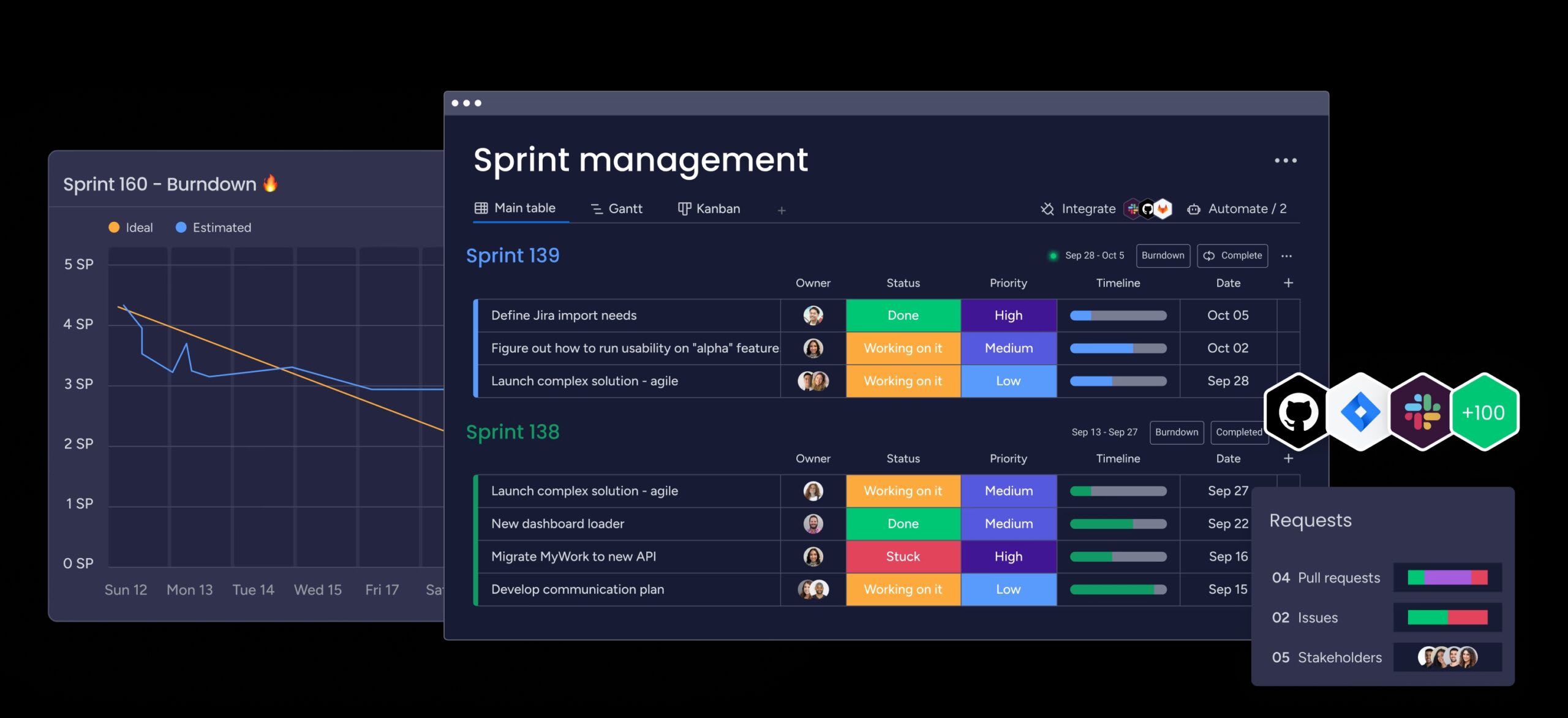
By following these best practices, teams can ensure their Scrum of Scrum meetings are efficient, productive, and aligned with the project goals. And using the right platform to manage them will make your meetings even more effective.
Try monday devHow monday dev can help streamline your Scrum of Scrums
With monday dev, built on the robust monday.com Work OS, you have all the latest information at your fingertips in one collaborative platform. With multiple ways to visualize and manage your sprints, you can see what teams are currently working on and which tasks are behind schedule when running your Scrum of Scrum meetings.
- Dashboards: Automatically populate custom dashboards with high-level and granular insights from up to 50 boards for smarter decision-making at your Scrum of Scrum meetings.

- Reports: Generate automated reports, like Burndown charts, to quickly visualize cross-team progress, blockers, and metrics to discuss in the meeting.
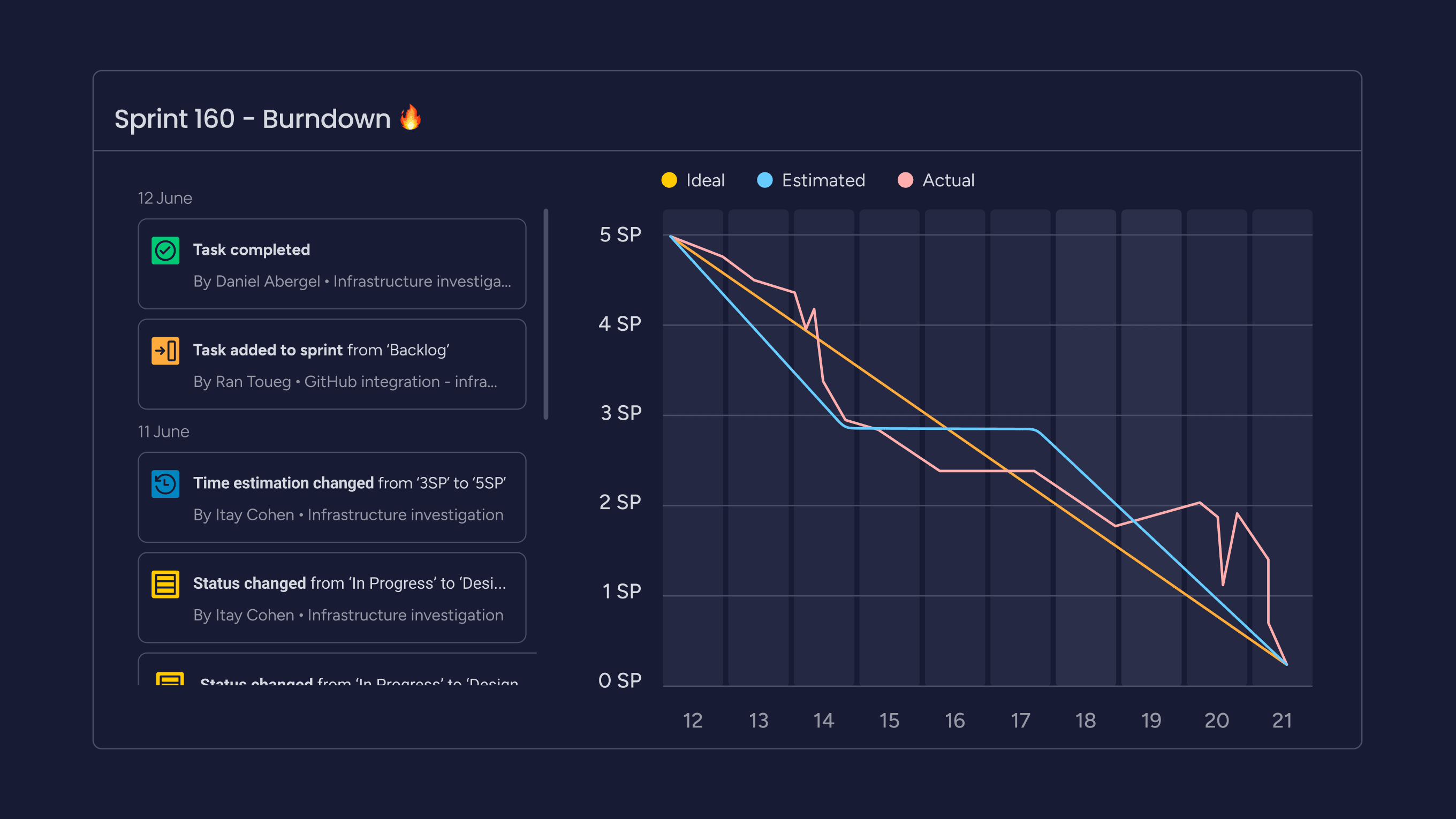
- Collaboration: Use features like @mentions, comments, and document sharing to facilitate communication between teams before and after the Scrum of Scrums meeting.
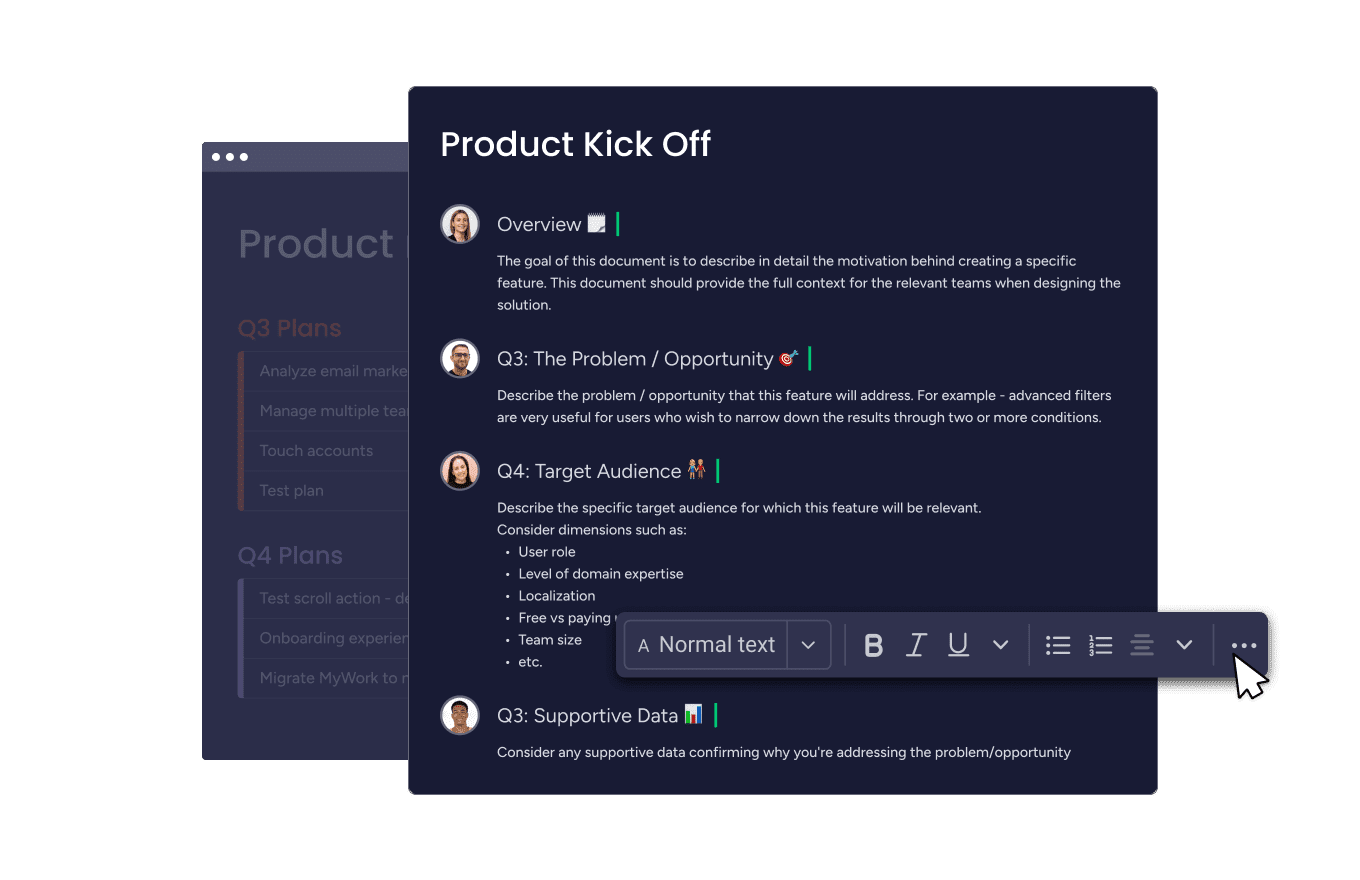
- Automations: Set up automations to streamline repetitive tasks related to the Scrum of Scrums process, like sending meeting reminders or updating status reports.
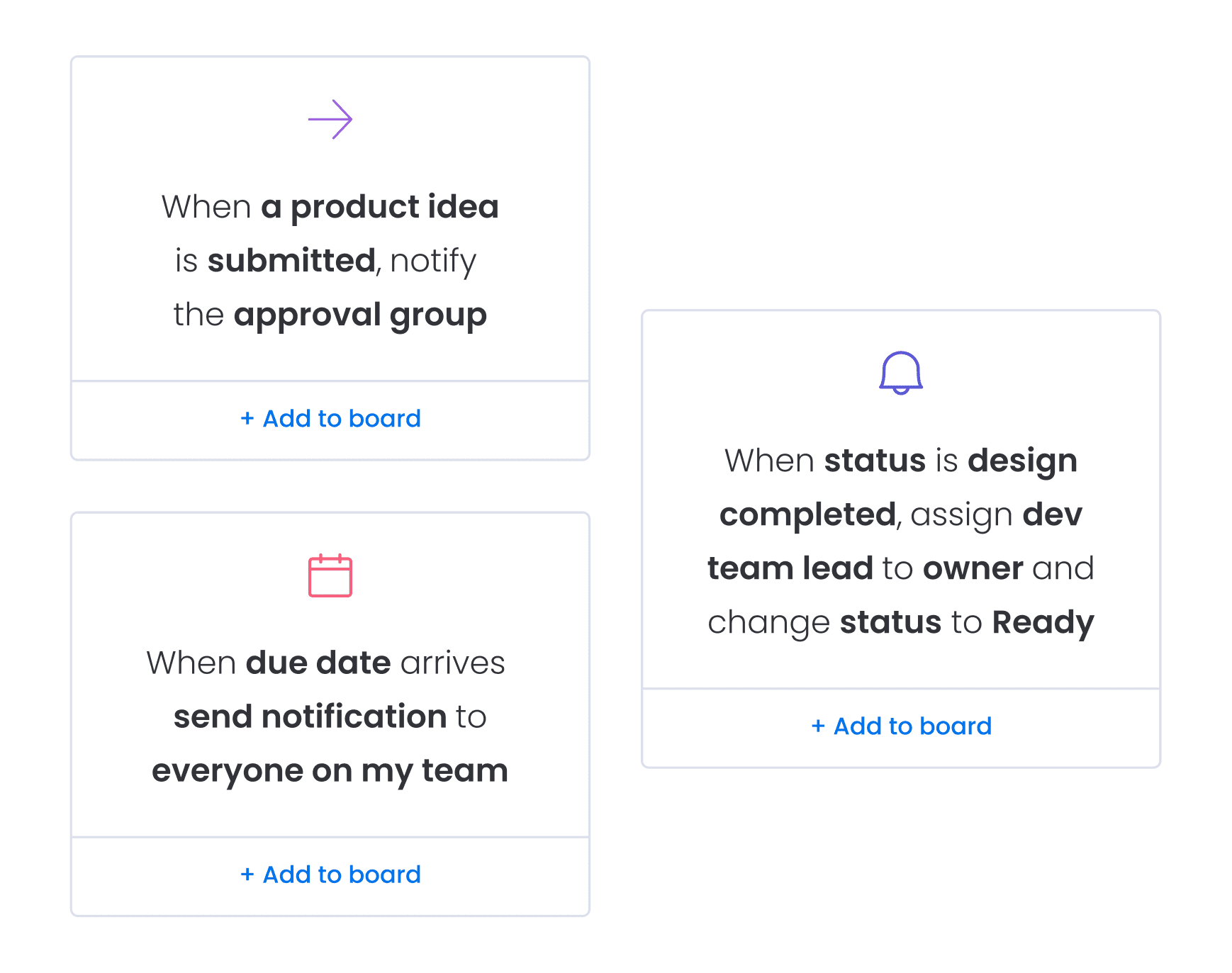
- Integrations: Connect monday dev with the tools you already use, like GitHub and Figma, to aggregate data from different sources.

Start using monday dev today and see how easy it is to plan and run your Scrum of Scrum meetings.
FAQs
What is the difference between Scrum and Scrum of Scrums?
While Scrum is a framework for managing a single team's work, Scrum of Scrums is a technique for scaling Scrum to larger projects or organizations involving multiple teams.
What is the difference between the Daily Scrum and Scrum of Scrums meetings?
A Daily Scrum is a 15-minute event held daily for a single Scrum team, where team members synchronize their work, discuss progress towards the Sprint Goal, and plan for the next 24 hours. It focuses on the work within a single team's Sprint Backlog.
In contrast, a Scrum of Scrums is a coordination meeting for multiple Scrum teams working on related projects or a large-scale initiative. It involves representatives from each team, can be held less frequently (often 2-3 times a week), and can last longer. The Scrum of Scrums addresses inter-team coordination, dependencies, and larger project goals, helping to integrate work across multiple teams.
What is the goal of the Scrum of Scrums event?
The Scrum of Scrums event aims to facilitate coordination, problem-solving, and alignment across multiple Scrum teams to deliver large-scale projects or products successfully.
- Tags:
- Scrum methodology
 Try monday dev
Try monday dev 


